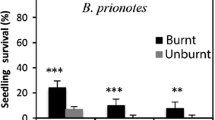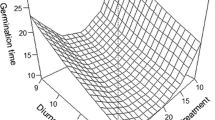Abstract
Globally, variability in canopy seed retention within closed cones (serotiny) among fire-adapted plant species is often associated with gradients in fire regime. Few studies have investigated the association of intraspecific variation in serotiny with geographical variation in fire and other environmental factors, especially climatic ones, and none has done so in the Cape Floristic Region (CFR) of South Africa. Yet the relationship between environmental gradients and intraspecific variation in reproductive traits may help us understand if those gradients partly shaped the evolution of the rich diversity or proteas in the CFR, and predict the resilience of fire-adapted Protea species to climate and fire regime changes in the CFR. We examined the association of the variability in serotiny in Protea repens (L.) L, the Common Sugarbush, with gradients in fire regime and climatic factors, and with plant age, cone age, and age of oldest closed cone across its 700 km-long longitudinal range in the CFR. Cone age was a significant covariate of the probability that a given cone was closed (our measure of serotiny), but plant age and age of oldest closed cone were not. Variability in the degree of serotiny was significant among populations. Serotiny was highest where fire intensity was historically high, where both mean annual precipitation and mean annual temperature were low, and where rainfall was least seasonal, but fire frequency was not a predictor of serotiny.




Similar content being viewed by others
References
Akman M, Carlson JE, Holsinger KE, Latimer AM (2016) Transcriptome sequencing reveals population differentiation in gene expression linked to functional traits and environmental gradients in the South African shrub Protea repens. New Phytol 210:295–309
Bates D, Mächler M, Bolker B, Walker S (2015) Fitting linear mixed-effects models using lme4. J Stat Soft. https://doi.org/10.18637/jss.v067.i01
Bond WJ (1984) Fire survival of Cape Proteaceae: influence of fire season and seed predators. Vegetatio 56:65–74
Bond WJ (2003) Fire. In: Cowling RM, Richardson DM, Pierce SM (eds) Vegetation of Southern Africa. Cambridge University Press, Cambridge, pp 421–446
Bond WJ, Keeley JE (2005) Fire as a global ‘herbivore’: the ecology and evolution of flammable ecosystems. Trends Ecol Evol 20:387–394
Buma B, Brown CD, Donato DC, Fontaine JB, Johnstone JF (2013) The impacts of changing disturbance regimes on serotinous plant populations and communities. Bioscience 63:866–876
Burnham KP, Anderson DR (2004) Multimodel inference: understanding AIC and BIC in model selection. Sociol Methods Res 33(2):261–304
Carlson JE, Adams CA, Holsinger KE (2015) Intraspecific variation in stomatal traits, leaf traits and physiology reflects adaptation along aridity gradients in a South African shrub. Ann Bot 117(1):195–207
Cowling RM, Lamont BB (1985) Variation in serotiny of three Banksia species along a climatic gradient. Austral Ecol 10:345–350
Cramer MD, Midgley JJ (2009) Maintenance costs of serotiny do not explain weak serotiny. Austral Ecol 34:653–662
de Gouvenain RC, Delgadillo J (2012) Geographical variation in population demography and life history traits of Tecate cypress (Hesperocyparis forbesii) suggests a fire regime gradient across the USA–Mexico border. Plant Ecol 213:723–733
de Klerk HM (2008) A pragmatic assessment of the usefulness of the MODIS (Terra and Aqua) 1-km active fire (MOD14A2 and MYD14A2) products for mapping fires in the fynbos biome. Int J Wildland Fire 17:166–178
Enright NJ, Lamont BB (1989) Fire temperatures and follicle-opening requirements in 10 Banksia species. Austral Ecol 14:107–113
Enright NJ, Marsula R, Lamont BB, Wissel C (1998) The ecological significance of canopy seed storage in fire-prone environments: a model for non-sprouting shrubs. J Ecol 86:946–959
Enright NJ, Fontaine JB, Lamont BB, Miller BP, Westcott VC (2014) Resistance and resilience to changing climate and fire regime depend on plant functional traits. J Ecol 102:1572–1581
Gauthier S, Bergeron Y, Simon JP (1996) Effects of fire regime on the serotiny level of jack pine. J Ecol 84:539–548
Giglio L, Descloitres J, Justice CO, Kaufman YJ (2003) An enhanced contextual fire detection algorithm for MODIS. Remote Sens Environ 87:273–282
Giglio L, Csiszar I, Justice CO (2006a) Global distribution and seasonality of active fires as observed with the Terra and Aqua Moderate Resolution Imaging Spectroradiometer (MODIS) sensors. J Geophys Res 111(G2):1–12
Giglio L, Van Der Werf GR, Randerson JT, Collatz GJ, Kasibhatla P (2006b) Global estimation of burned area using MODIS active fire observations. Atmos Chem Phys 6:957–974
Giglio L, Schroeder W, Justice CO (2016) The collection 6 MODIS active fire detection algorithm and fire products. Remote Sens Environ 178:31–41
Givnish TJ (1981) Serotiny, geography, and fire in the Pine Barrens of New Jersey. Evolution 35:101–123
Goubitz S, Nathan R, Roitemberg R, Shmida A, Ne’eman G (2004) Canopy seed bank structure in relation to: fire, tree size and density. Plant Ecol 173:191–201
Groom PK, Lamont BB (1997) Fruit-seed relations in Hakea: serotinous species invest more dry matter in predispersal seed protection. Austral Ecol 22:352–355
Harris W (2002) Variation of inherent seed capsule splitting in populations of Leptospermum scoparium (Myrtaceae) in New Zealand. N Z J Bot 40:405–417
Hilborn R, Mangel M (1997) The ecological detective. Princeton University Press, Princeton
Justice CO, Giglio L, Korontzi S, Owens J, Morisette JT, Roy D, Descloitres J, Alleaume S, Petitcolin F, Kaufman Y (2002) The MODIS fire products. Remote Sens Environ 83:244–262
Keeley JE, Fotheringham CJ (2001) Historic fire regime in Southern California shrublands. Conserv Biol 15:1536–1548
Keeley JE, Zedler PH (2009) Large, high-intensity fire events in southern California shrublands: debunking the fine-grain age patch model. Ecol Appl 19:69–94
Ladd PG, Midgley JJ, Nield AP (2013) Serotiny in southern hemisphere conifers. Aust J Bot 61:486–496
Lamont BB, Enright NJ (2000) Adaptive advantages of aerial seed banks. Plant Species Biol 15:157–166
Lamont BB, He T (2012) Fire-adapted Gondwanan angiosperm floras evolved in the Cretaceous. BMC Evol Biol 12:1–11
Lamont BB, He T (2016) Fire-proneness as a prerequisite for the evolution of fire-adapted traits. Trends Plant Sci 22(4):278–288
Lamont BB, Le Maitre DC, Cowling RM, Enright NJ (1991) Canopy seed storage in woody plants. Bot Rev 57:277–317
Lamont BB, Written VA, Witkowski ETF, Rees RG, Enright NJ (1994) Regional and local (road verge) effects on size and fecundity in Banksia menziesii. Aust J Ecol 19:197–205
Lamont BB, He T, Downes KS (2013) Adaptive responses to directional trait selection in the Miocene enabled Cape proteas to colonize the savanna grasslands. Evol Ecol 27:1099–1115
Latimer A, Silander JA Jr, Rebelo AG, Midgley GF (2009) Experimental biogeography: the role of environmental gradients in high geographic diversity in Cape Proteaceae. Oecologia 160:151–162
Lindner M, Maroschek M, Netherer S, Kremer A, Barbati A, Garcia-Gonzalo J, Seidl R, Delzon S, Corona P, Kolström M, Lexer MJ, Marchetti M (2010) Climate change impacts, adaptive capacity, and vulnerability of European forest ecosystems. For Ecol Manage 259:698–709
Logan M (2010) Biostatistical design and analysis using R. Wiley, Oxford
Malcolm JR, Liu C, Neilson RP, Hansen L, Hannah L (2006) Global warming and extinctions of endemic species from biodiversity hotspots. Conserv Biol 20:538–548
Manry DE, Knight RS (1986) Lightning density and burning frequency in South African vegetation. Vegetatio 66:67–76
Merow C, Latimer AM, Wilson AM, McMahon SM, Rebelo AG, Silander JA Jr (2014) On using integral projection models to generate demographically driven predictions of species’ distributions: development and validation using sparse data. Ecography 37:1167–1183
Midgley J (2000) What are the relative costs, limits and correlates of increased degree of serotiny? Austral Ecol 25:65–68
Midgley J, Bond W (2011) Pushing back in time: the role of fire in plant evolution. New Phytol 191:5–7
Midgley J, Enright NJ (2000) Serotinous species show correlation between retention time for leaves and cones. J Ecol 88:348–351
Minnich RA (2001) An integrated model of two fire regimes. Conserv Biol 15:1549–1553
Mitchell N, Moore TE, Mollmann HK, Carlson JE, Mocko K, Martinez-Cabrera H, Adams C, Silander JA Jr, Jones CS, Schlichting CD, Holsinger KE (2015) Functional traits in parallel evolutionary radiations and trait-environment associations in the Cape Floristic Region of South Africa. Am Nat 185:525–537
Muir PS, Lotan JE (1985) Disturbance history and serotiny of Pinus contorta in western Montana. Ecology 66:1658–1668
NASA (National Aeronautic and Space Administration) (2017) Fire information for resource management Ssystem (FIRMS). https://earthdata.nasa.gov/earth-observation-data/near-real-time/firms. Accessed 5 June 2017
Parchman TL, Gompert Z, Mudge J, Schilkey FD, Benkman CW, Buerkle CA (2012) Genome-wide association genetics of an adaptive trait in lodgepole pine. Mol Ecol 21:2991–3005
Pausas JG, Bradstock RA, Keith DA, Keeley JE (2004) Plant functional traits in relation to fire in crown-fire ecosystems. Ecology 85:1085–1100
Prunier R, Holsinger KE (2010) Was it an explosion? Using population genetics to explore the dynamics of a recent radiation within Protea (Proteaceae L.). Mol Ecol 19:3968–3980
QGIS Development Team (2017) QGIS Geographic Information System. Open Source Geospatial Foundation Project. https://www.qgis.org/en/site/
R Core Team (2013) R: a language and environment for statistical computing. R Foundation for Statistical Computing, Vienna
Rebelo T (1995) Sasol proteas: a field guide to the proteas of Southern Africa. Fernwood Press (Pty) Ltd., Pretoria
Scheiter S, Higgins SI, Osborne CP, Bradshaw C, Lunt D, Ripley BS, Taylor LL, Beerling DJ (2012) Fire and fire-adapted vegetation promoted C4 expansion in the late Miocene. New Phytol 195:653–666
Schnitzler J, Barraclough TG, Boatwright JS, Goldblatt P, Manning JC, Powell MP, Rebelo T, Savolainen V (2011) Causes of plant diversification in the Cape biodiversity hotspot of South Africa. Syst Biol 60:343–357
Schoennagel T, Turner MG, Romme WH (2003) The influence of fire interval and serotiny on postfire lodgepole pine density in Yellowstone National Park. Ecology 84:2967–2978
Schulze RE (2007) South African atlas of climatology and agrohydrology. Water Research Commission, Pretoria
Schwilk DW, Ackerly DD (2001) Flammability and serotiny as strategies: correlated evolution in pines. Oikos 94:326–336
Scott L, Anderson HM, Anderson JM (2003) Vegetation history. In: Cowling RM, Richardson DM, Pierce SM (eds) Vegetation of Southern Africa. Cambridge University Press, Cambridge, pp 62–84
Tapias R, Climent J, Pardos JA, Gil L (2004) Life histories of Mediterranean pines. Plant Ecol 171:53–68
Tonnabel J, Van Dooren TJM, Midgley J, Haccou P, Mignot A, Ronce O, Olivieri I (2012) Optimal resource allocation in a serotinous non-resprouting plant species under different fire regimes. J Ecol 100:1464–1474
Tonnabel J, Mignot A, Douzery EJP, Rebelo AG, Schurr FM, Midgley J, Illing N, Justy F, Orcel D, Olivieri I (2014) Convergent and correlated evolution of major life-history traits in the angiosperm genus Leucadendron (Proteaceae). Evolution 68:2775–2792
Wills TJ (2003) Using Banksia (Proteaceae) node counts to estimate time since fire. Aust J Bot 51:239–242
Wilson AM, Latimer AM, Silander JA Jr (2015) Climatic controls on ecosystem resilience: postfire regeneration in the Cape Floristic Region of South Africa. Proc Natl Acad Sci 112:9058–9063
Zuur A, Ieno EN, Walker N, Saveliev AA, Smith GM (2009) Mixed effects models and extensions in ecology with R. Springer, New York
Zuur A, Ieno EN, Elphick CS (2010) A protocol for data exploration to avoid common statistical problems. Methods Ecol Evol 1:3–14
Acknowledgements
We thank Jasper Slingsby, Tony Rebelo, Tom Slingsby, and Nick Lindenberg for their help. Kobus Kellerman and Jocelyne de Gouvenain assisted with the field sampling. Jane Carlson generously provided UTM coordinates of P. repens populations. John Silander Jr. reviewed the draft manuscript. We thank CapeNature, the Eastern Cape Parks and Tourism Agency, and the South African National Parks for permission to sample populations of P. repens under their jurisdiction. RdG thanks the University of Cape Town Biological Sciences Department for in-kind support and JM’s hospitality while conducting sabbatical research in his lab. We thank three anonymous reviewers for their thorough and constructive comments.
Author information
Authors and Affiliations
Corresponding author
Additional information
Communicated by Neal J. Enright.
Rights and permissions
About this article
Cite this article
de Gouvenain, R.C., Midgley, J.J. & Merow, C. Serotiny in the South African shrub Protea repens is associated with gradients of precipitation, temperature, and fire intensity. Plant Ecol 220, 97–109 (2019). https://doi.org/10.1007/s11258-018-00905-w
Received:
Accepted:
Published:
Issue Date:
DOI: https://doi.org/10.1007/s11258-018-00905-w




